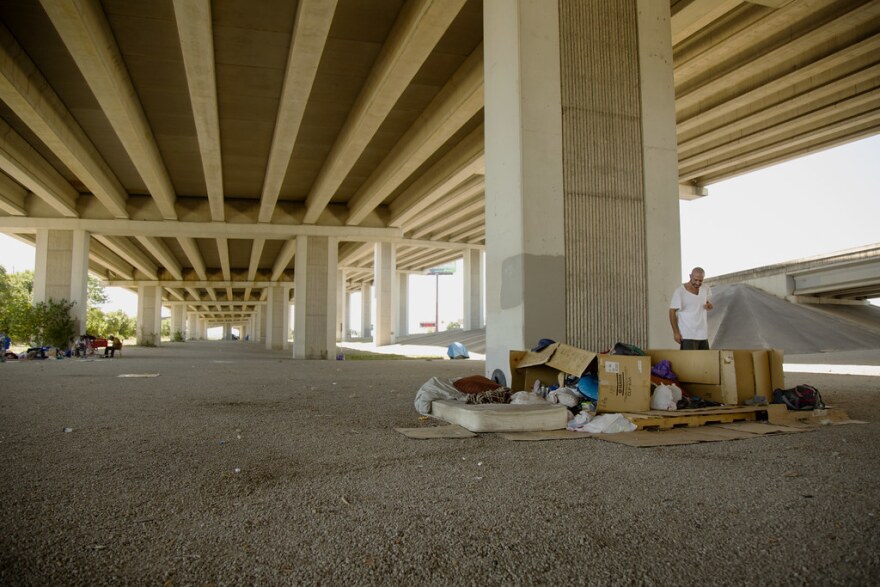The Austin City Council provided some clarity Tuesday over where it will limit camping and resting in public, as well as its overall strategy to boost citywide, housing-focused initiatives and investments.
Council members heard a briefing from city staff on a memo released last week on solutions to homelessness in Austin – one that suggested the city abandon the prospect of city-sanctioned camping and parking areas for Austinites experiencing homelessness. City staff also suggested curtailing public areas where people could sit, lie or camp, saying neither align with the city's housing-first strategy.
RELATED | Watch: KUT's Discussion On Homelessness In Austin
Before the meeting, council members released a document outlining possibilities going forward, suggesting the city could limit camping or resting near:
- Streets with heavy foot traffic like Congress Avenue, Guadalupe Street and Sixth Street
- the Austin Resource Center for the Homeless or other service facilities
- schools and child care facilities
- medians or other areas near roadways
- sidewalks and areas in front of businesses
District 4 Council Member Greg Casar – who pushed for the city's June 20 scale-back of homelessness ordinances – said he was interested in "carefully tailored, nondiscriminatory restrictions." But Casar expressed concern that council not backslide into the old rules, which he and others said criminalized behavior associated with homelessness.
"I just think that, as we work on that, we have to be really careful to make sure that we don't re-criminalize the mere status of being homeless," he said. "And I don't think that's anybody's intent."
The discussion Tuesday also centered around longer-term solutions to house people experiencing homelessness, including the city's investment in the Salvation Army's 225-bed Rathgeber Center in East Austin, its establishment of a public-private fund to house chronically homeless Austinites, and transitional and permanent housing efforts funded by the 2018 housing bond.
Council Member Kathie Tovo questioned staff on short-term efforts to provide cleanups outside the city's pilot program– known as the purple bag program – which provides trash bags for encampments and pickup at four sites.
"I can't explain to people why we have not been able to do that at our underpasses, along Red River and in other areas where we need them," she said. "I really very much appreciate the purple bag pilot, but we have so many more sites that need trash pickup."
Public Works Director Richard Mendoza said the city may have to make a deal with the Texas Department of Transportation to clean up underpasses, because some of them fall within TxDOT right-of-ways. He said the department would report back to council on those conversations.
Tovo also requested updates on the city's efforts to provide three public restrooms. Mendoza said two of those portable toilets should be delivered to the city in November and the third is expected to be in Austin by the first of next year.
Council Member Alison Alter said the city is in an "in-between place" as it relates to homelessness. Camps have proliferated and become more visible since the June 20 vote, as the city awaits long-term solutions like more permanent and temporary housing for people transitioning out of homelessness.
"I think we're trying to find ways to move in the short-term. We have plans in place to provide a lot of the housing-first solutions, but that takes a lot of time and it takes money," Alter said. "And we now have to deal with a situation on our hands – and we can debate how we got to that situation – but the fact is, we have a problem on our hands that we, as a community, have decided to address."
Alter said she's received constituent questions about what residents can do if someone camps on or near residential property – a question to which she said she hasn't seen a clear answer. The outline revealed today suggested neighborhoods or organizations could request the city "restrict camping in a certain place" if they help find a "better, safer and more desirable place."
Assistant City Manager Rodney Gonzales said city staff would come back to council to provide clearer enforcement guidance that is within the new rules. Council members' outline suggested clearer definitions of "threatening" behavior and what constitutes a safety and public health risk.
"We do have to be very careful, in light of council's ... ordinance changes from June, so as not to criminalize individuals, which makes their situation worse," he said.
The discussion was prompted by a resolution on June 20 that asked the city manager to find solutions to homelessness.
The city manager's office is expected to provide a larger list of options to council by the end of the month. Council members said Tuesday they could act on those suggestions by September.






